From time to time our readers ask us how a certain device compares to another - an understandable question, but one that it is often difficult (or impossible) to respond adequately to. From a practical point of view, the difficulty is in having all of the necessary devices available simultaneously for testing in real-time, and from an objective point of view, well, it's just difficult to be objective (each to their own, after all)!
So we made sure to have all four digital amplifiers at our disposal for testing simultaneously (which is easier than testing four different types of Column Speaker!). All four have previously been the subject of a trademark Qobuz benchmark, so we decided to offer up a little friendly competition between the four, which we will now proceed to list alphabetically (thus avoiding any potential premature favouritism in the rankings: the FX-Audio D802, the NuForce DDA120, the SMSL Pro Q5, and the Topping VX2.
This particular exercise is new to us, but we wanted to cover the important information in this four-way comparison, and therefore will provide a small technical section which will cover the essential, and give a global view of the insides of each device along with a section describing the amplifiers.
The aim here is not to establish a formal hierarchy, but rather issue opinions and assessments as objectively as possible, and we conclude with a brief summary on each device.
Outline of the candidates
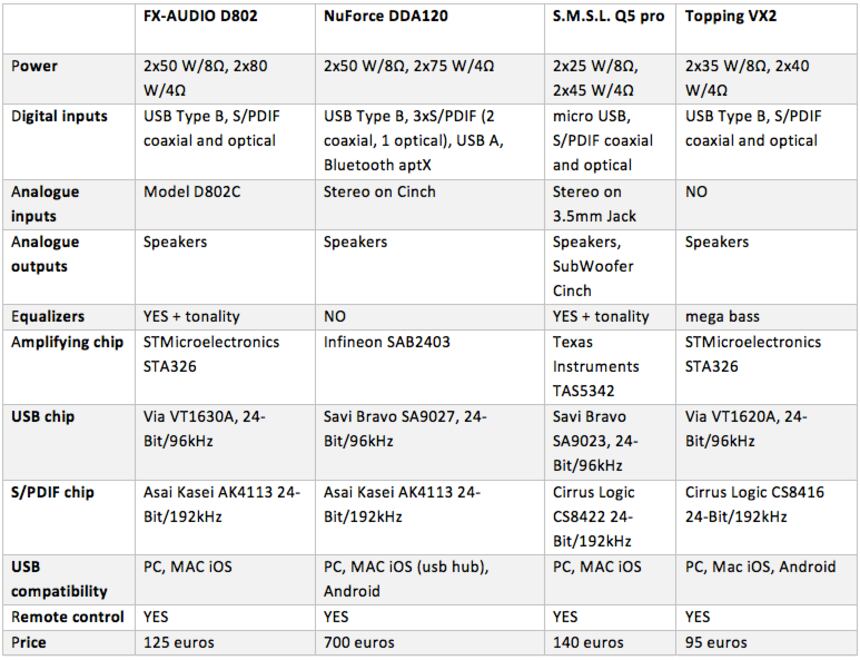
Appearance of FX-Audio D802
A rather austere presentation with a grey-black finish for the FX-Audio D802, whose facade is pretty loaded with inscriptions and a 'mute' LED remains lit continuously to indicate that in fact the internal relays connect the speakers to the amplifiers (does not turn off when we activate 'mute' on the remote control, although it is probably acting by setting the level to 0). The Power is controlled by the leftmost button of the facade, with the one next to it is used to choose the digital input. A small central display displays the type of OLED in service, the volume, sampling frequency, while bass and treble settings are accessed by applying pressure on the volume button.
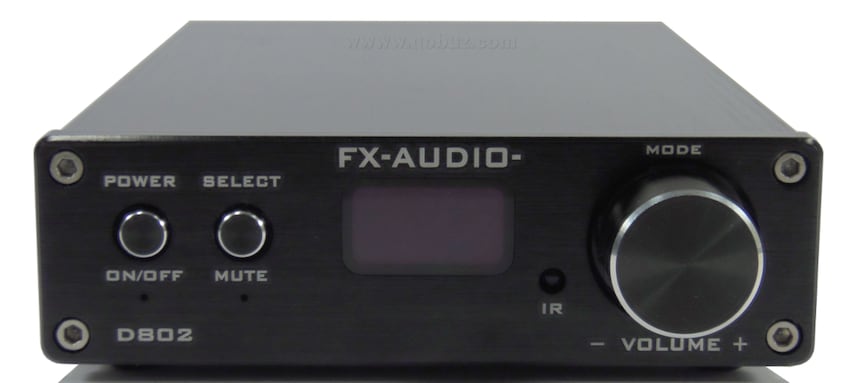
There are three digital inputs for the D802, a USB type B to connect to a computer, smartphone or tablet (iOS or Android), and two S/PDIF inputs (one coaxial and one optical). The connection to the speakers is through small-sized terminals accepting banana plugs as well as naked wire.
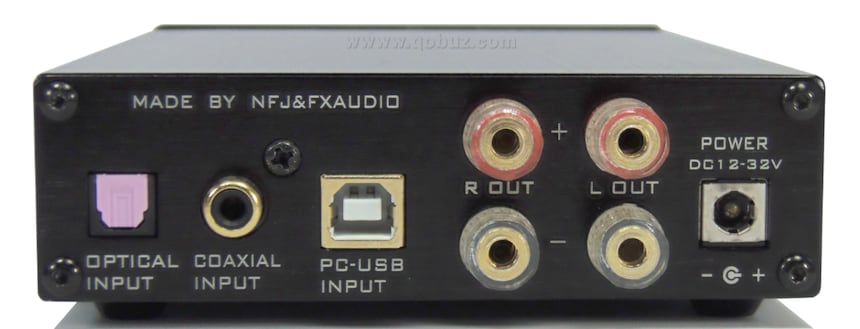
Appearance of NuForce DDA120
Very bare, but pure and of a certain class, the facade of the NuForce DDA120, which is made entirely of aluminum (sandblasted natural, anodised or anthracite), reveals various displays (sources on the left and volume more to the right), with those in the middle corresponding to the infrared remote control receiver. The volume control knob is also used to turn the device on and off through prolonged pressure and source of change by pressing briefly.
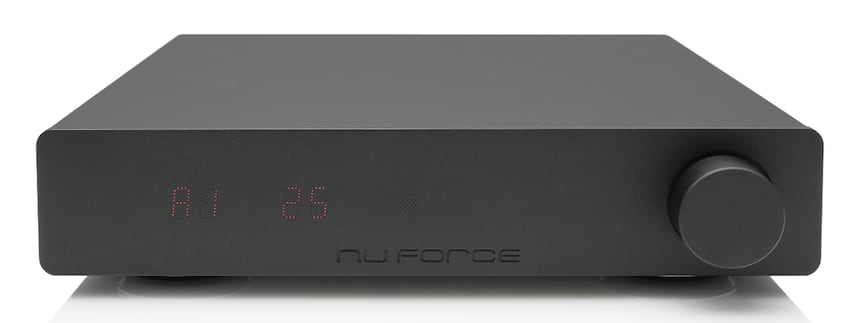
The rear face of the DDA120 welcomes terminals to the speakers, a USB plug type B to connect to a computer, a coaxial S/PDIF input as well as two optical, one optical S/PDIF output, an analog stereo input and a USB Type A connector christened 'Expansion Slot', and with which the USB Bluetooth receiver apt-X BTR-01 supplied can be connected.

Appearance of S.M.S.L Q5 Pro
S.M.S.L Q5 pro amplifier is made entirely from brushed anodized aluminum in natural or black finish. An undeniably elegant facade, the horizontal edges are grooved along much of their length. The small button on the left side of the facade allows starting or stopping by applying extended pressure, or a change of input by pressing briefly. The display always shows the volume and the selected entry, and temporarily displays adjustments in bass or treble levels.
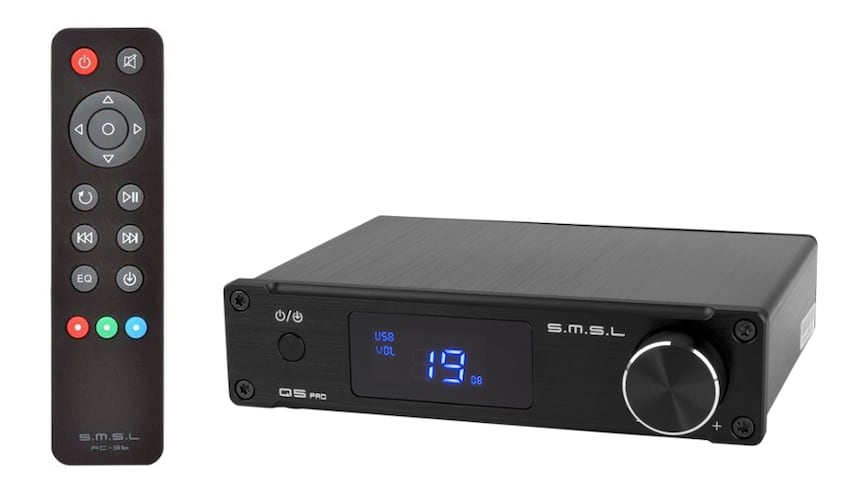
At the rear, three digital inputs, a USB microphone (24 bits at 96 kHz) to connect to a computer (PC or Mac) or to a tablet or a smartphone running iOS, and two S / PDIF inputs (coaxial and optical, 24 bit 192 kHz). An analog stereo source can also be plugged into a jack 3.5 mm, the signals are digitized internally. An output on RCA jack lets you connect a subwoofer while the speakers will be connected to the small connectors that accept banana plugs or bare wire.

Appearance of Topping VX2
Quite elegantly presented, the Topping VX2 amplifier is made entirely from anodized brushed aluminum, and its facade is available in a black or gray finish. Two small toggle switches are found on its left side (the first is for power, while the second, with three positions, selects one of three digital inputs: USB, optical or coaxial. In the center, a large display with blue numbers indicates the volume from 00 to 99, while the decimal point in the lower right corner lights up when activated the bass boost (mega bass) by pressing the button volume located in the right part of the facade.
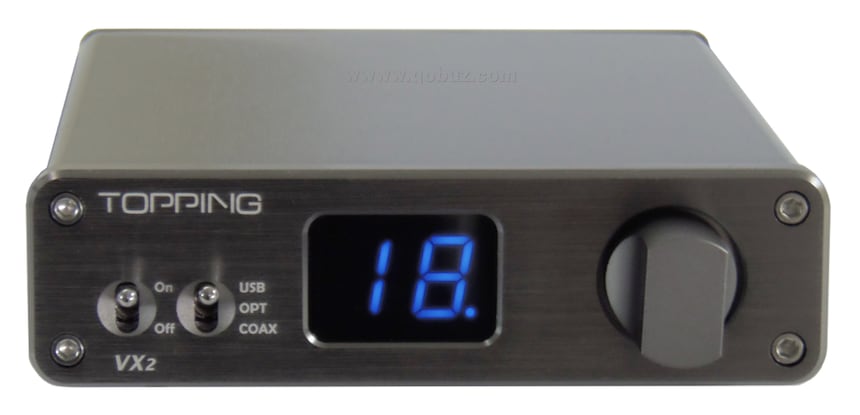
The rear panel contains the USB input B, the S/PDIF (coaxial and optical) input, terminals for the speakers that accept banana plugs and the socket for the power supply.
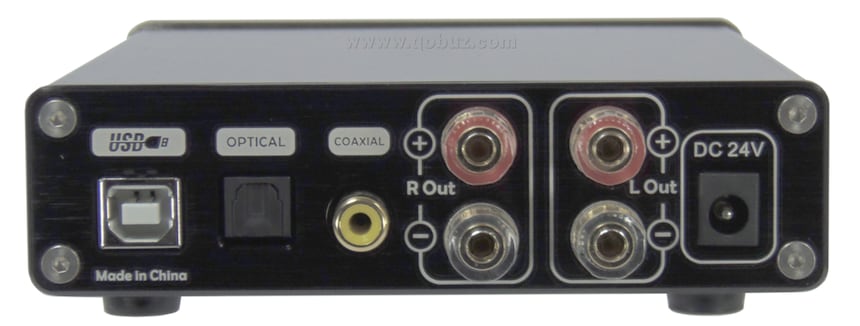
Manufacturing: FX-Audio D802
The cutting amplification of the D802 uses an original STMicroelectronics chip, in this case the STA326, a sophisticated model that also has thirty two preset equalization curves, automatic loudness control, customised equalizer settings pre-programmed by the designer, control of bass and treble, and volume adjustment. Despite its high power of 2 x 50W in 8Ω, the excellent yield given off allows only for the use of a very reasonably-sized cooling radiator. In the area of outputs, the STA326 boasts filter circuits composed of inductors and plastic dielectric capacitors, which will transform the amplifier signals into analog signals usable by speaker. Between these cells, three Nichicon 1800uF/35V electrochemical capacitors serve as standby current to the amplifier.
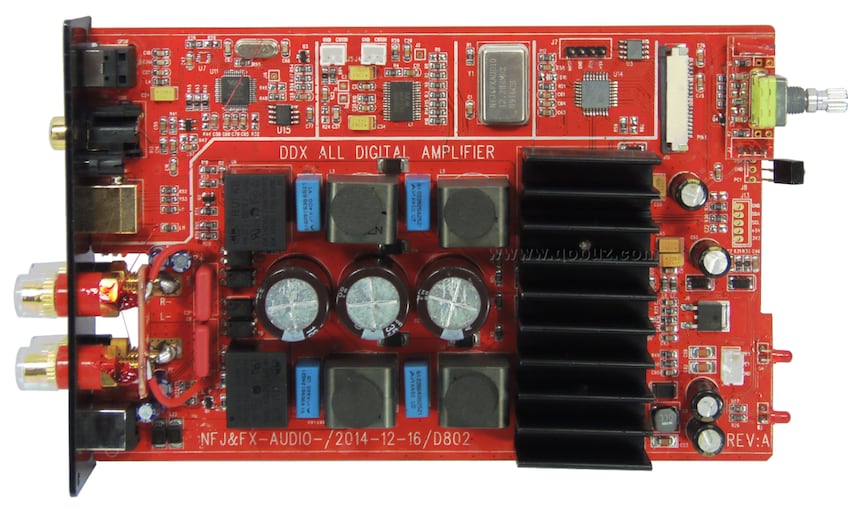
Manufacturing: NuForce DDA120
The largest amplifier of the four, the DDA120 uses two Infineon amplifiers (type SAB2403) which provide the power source of 2 x 50W/8Ω to the speakers. Filtering is entrusted to an inductor and to plastic capacitors (brand:Wima), which we personally think is better for musicality as chemical capacitors found on other devices. We note also the presence of "big" electrochemical capacitors manufactured to NuForce specifications, whose value is not indicated. These are associated with inductors (upper part of the picture) to provide effective filtering of supply voltages of the amplifiers.
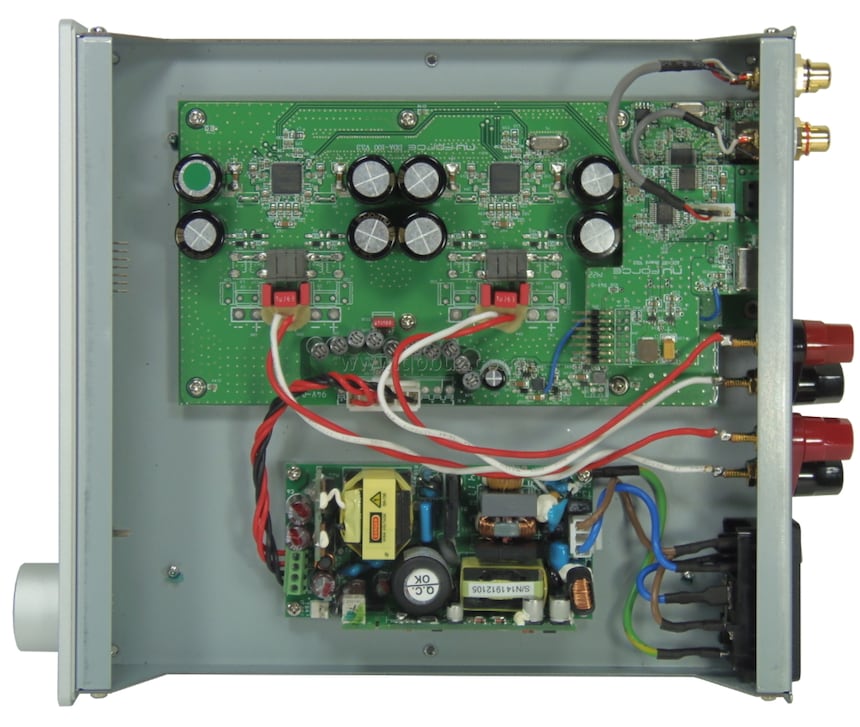
Manufacturing: S.M.S.L Q5 pro
Le S.M.S.L Q5 pro uses a Texas Instruments TAS5508 PWM processor which will convert digital signals from the source selected into pulse width modulated signals (or Pulse Width Modulation, abbreviated PWM), which is the basic principle of switched-mode amplification. The TAS5508 then pilots another Texas Instruments circuit, the TAS5342, which includes among others the MosFet transistors, thz LED with a finned radiator to dissipate the heat it may release despite its good performance. We note also the large electrolytic capacitor of 3900 ΩF/25V serving as a reservoir for current amplification. The active filter for the subwoofer is built around an operational amplifier NE5532 low noise.
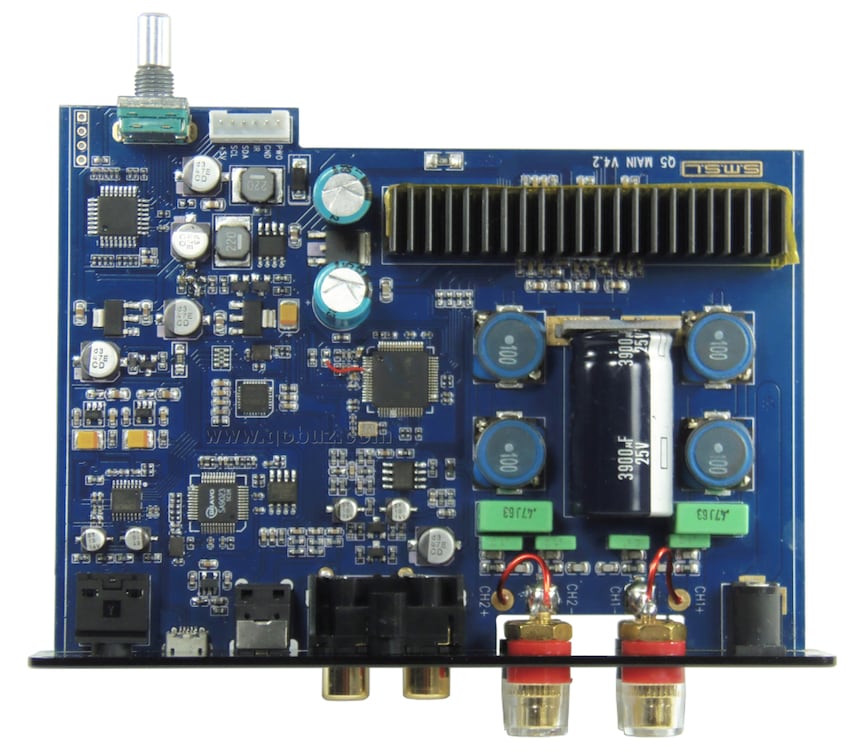
Manufacturing of Topping VX2
Except for the display and the volume control, which are both situated on a small circuit mounted on the facade, the electronics of the Topping VX2 are assembled on a relatively densely packed single circuit. The switching amplifier is an STA326 model from STMicroelectronics that integrates, among other features, an equalizer with programmed curves, a tone control and bass management, this feature is only for use by Topping the VX32 order to have an opportunity to strengthen the grave. But, according to our findings when listening, the dynamic limiter built into this amplifier seems to have been turned on without him being mentioned. The signals from this STA326 then pass through low-pass filters consisting of inductors and capacitors plastic layers before being switched to the output terminals through two relays.
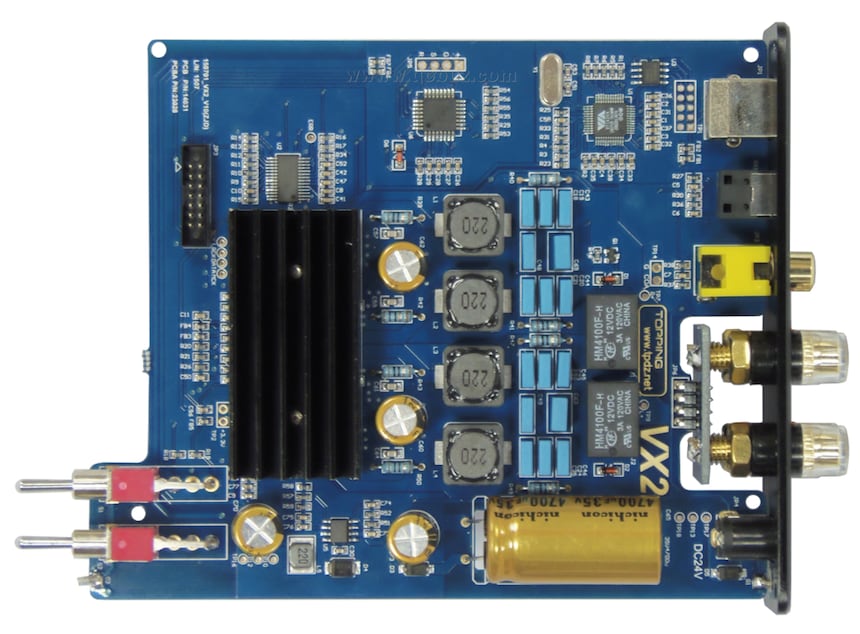
Listening
Extract N°1 :
Dvorak: Allegro II, Suite Américaine, Festival of Budapest Orchestra under the direction of Ivan Fischer.
FX-Audio D802 - The power comes without having to do much teasing and high levels of volume is achieved quickly at high levels In return the latitude adjustment on the low levels is not wide. The sound quality is very lively, with punch and a certain density, but with a small tendency for treble.
Nuforce DDA120 - Restitution is vivid, fine, balanced and sparkling, but you really have to push the volume to obtain a sound level that gives real body to the restitution and begins to stir eardrums.
S.M.S.L Q5 pro - Beautiful restitution, lively and balanced, with fine and flowing strings and treble that go well together. We nearly vibrate along with the cymbals, all with good monitoring of dynamics.
Topping VX2 - Relatively low power demand needed to change the setting to a value large enough to get a good sound level. Restitution is well balanced, seriously clean and thin on treble, but attacks during the high points (eg in the finale) are pretty gummed, a characteristic of this amplifier.
Extract N°2 :
Tchaikovsky: Allegro moderato, Violin Concerto, Patricia Kopatchinskaja on violin, the Ensemble MusicAeterna directed by Teodor Currentzis
FX-Audio D802 - Not easy to manage at low volumes, the D802 still proved to be quite expressive with the calm beginning of this concerto. The war machine goes pretty fast into the turns and again the power is obtained without the need to push much on the volume - a very pleasing punch.
Nuforce DDA120 - The dynamic width of Tchaikovsky's Violin Concerto, particularly on the discrete set of the orchestra and the soloist in the first movement, is carried with a very good definition and reproduces the wonderfully recorded movement with power and mastery.
S.M.S.L Q5 pro - The restitution of the first movement of this concerto is so detailed that it captures, for the listener, the significance of every inflection of the orchestra and soloist. The treble of the violin is discrete, but the introduction of the main theme is proof of a beautiful product here as the orchestra explodes. Masterful.
Topping VX2 - Air and finesse in the beginning of the first movement with a violin that both sings and scratches to wonderful effect. A little restraint when introducing the main theme, this one still gets a stamp of approval - the quality is definitely there.
Extract N°3 :
George Harrison: My Sweet Lord from the album All Things Must Pass
FX-Audio D802 - Dense restitution, with a lot of presence on the singer's voice and chorus, albeit a bit rich on the low end of the sound spectrum). Again we would like more progressiveness with the volume control here.
Nuforce DDA120 - The NuForce DDA120 offers beautiful sound reproduction with presence and good atmosphere, finesse on the singer's voice and the chorus, topped off with punctuated guitar chords that spin gracefully.
S.M.S.L Q5 pro - The S.M.S.L Q5 pro offers a fairly elegant restitution of this track - lacking perhaps only some presence on the singer's voice - but with beautiful guitar chords, well stitched into the top and guided ostensibly.
Topping VX2 - clean and airy restitution, without excess in way that everything is in place with choruses removed (subtly) from the vocals of the main interpreter and accompaniment worthy of the name, although at times we found it little quiet in the reproduction of deeper sounds.
To conclude: A few words about each amplifier
FX-Audio D802
The biggest of the small, with its austere appearance, quickly impresses with its punch and power coming from just the first few notches on the volume knob, and even moreso when we activate the Tone function, but it does not seem that we have a lack progressivity thereof. It offers many opportunities for equalization and its sound performances, for all its strength and power, lacks some finesse at times.
NuForce DDA120
Elegant and nuanced restitution, much like the presentation of the NuForce DDA120 itself. The largest (and most expensive) amplifier in this roundup, but the punch is right on time when the music demands it. No settings other than the volume, which provides progressive order to adjust the sound level with finesse. A fairly purist machine, you might say.
S.M.S.L Q5 pro
The smallest of the small, the SMSL Q5 pro provides sound reproduction that is a happy compromise between 'punch' and 'hold' with the sound balanced with finesse and nuance, although lacking some presence. We note the presence of an output for subwoofer.
Topping VX2
This device seems to be a somewhat milder version of the all-digital amplifier, allowing for advantages in terms of size and ease of use in this type of device. The only settings on the menu is the bass reinforcement. Clean sound reproduction, without excess and offering a good punch in the bass.
To follow everything that happens at Qobuz, like us on Facebook!
If you are a constructer, importer, distributor, or agent in the field of sound reproduction, and would like to contact us, please do so through the following address: newstech@qobuz.com
If you are passionate about the contents of our Hi-Fi Guide, and would like to contact us, then please do so through the following address: rubriquehifi@qobuz.com
